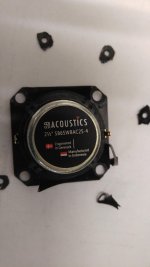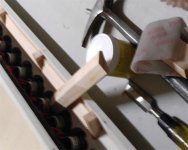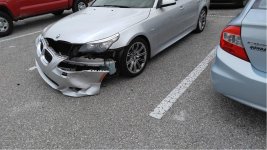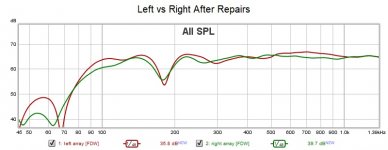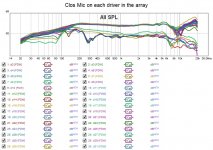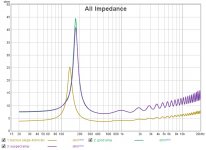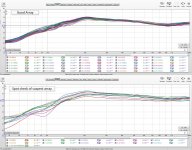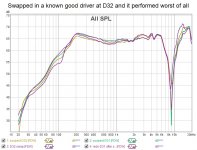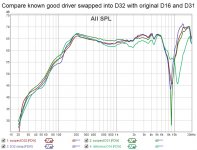at last, a cause that I can believe in
although I find it hard to believe that I only just now discovered it
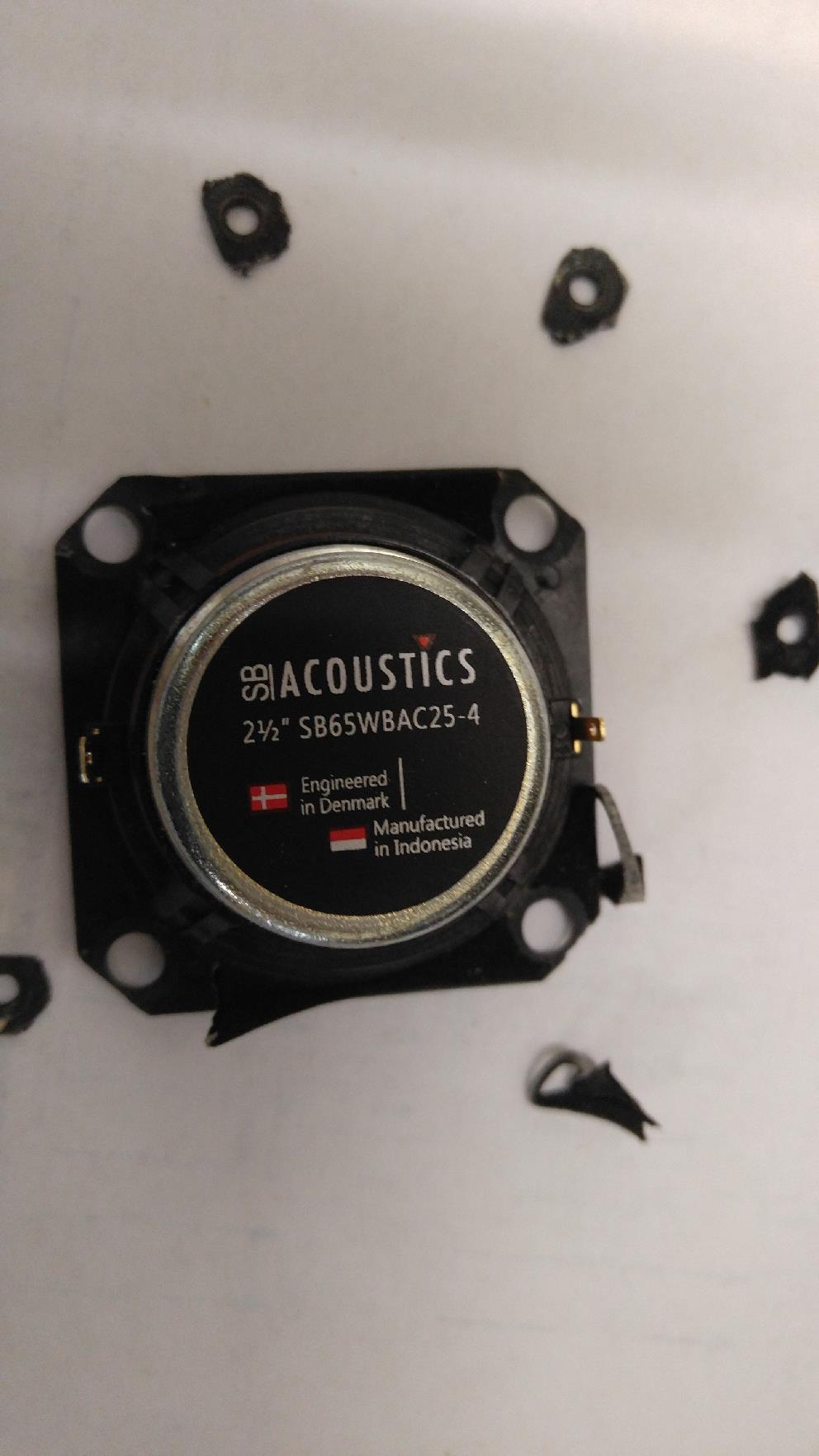
those little bits of plastic surrounding the driver broke off from the back of the driver mounting holes as might happen if the driver were smacked sharply on the back of its magnet with a hammer. of course nothing like that ever happened.
This was the top driver. The only thing I can think of is that when the array was knocked over and landed on the driver face, the delta MV over delta t on the top driver was too much for it. The array stopped abruptly but the driver kept going enough to fracture the plastic. A little bit of handling when I removed the back panel and there it was just hanging off the face of the baffle.
I looked at my early, pre-crash measurements, including one in same/similar position, and I don't see signs of that 200 hz null or early roll off in them.
I have one more virgin driver but I have to wait for the wood filler I put in the driver mounting holes before I install it
although I find it hard to believe that I only just now discovered it
those little bits of plastic surrounding the driver broke off from the back of the driver mounting holes as might happen if the driver were smacked sharply on the back of its magnet with a hammer. of course nothing like that ever happened.
This was the top driver. The only thing I can think of is that when the array was knocked over and landed on the driver face, the delta MV over delta t on the top driver was too much for it. The array stopped abruptly but the driver kept going enough to fracture the plastic. A little bit of handling when I removed the back panel and there it was just hanging off the face of the baffle.
I looked at my early, pre-crash measurements, including one in same/similar position, and I don't see signs of that 200 hz null or early roll off in them.
I have one more virgin driver but I have to wait for the wood filler I put in the driver mounting holes before I install it
Attachments
FWIW, I've used silicone on the insides of joints with great success.
I no longer think the joint was leaking but I do need to strengthen it.
I think I would have great difficulty creating a triangular piece to fit on the inside of the joint the entire length of the array on my table saw. Perhaps I can cut a few short pieces without cutting myself...
Bummer! But that smack to the floor could certainly explain it. Hope you can fix it. Something like this should be noticeable in an impedance plot.
Just happy I only seem to have lost one driver.
Working on the braces now. I think it will be fine...
Working on the braces now. I think it will be fine...
...when the array was knocked over and landed on the driver face, the delta MV over delta t on the top driver was too much for it.

FWIW, I've used silicone on the insides of joints with great success.
GE Iron Grip silicone adhesive:
http://irongripadhesive.com/wp-content/uploads/2016/06/GEIronGrip_TechnicalDataSheet_20160526.pdf
Available at Lowe’s, Home Depot, Walmart, etc.
Also recommended for attaching different materials, E6000:
E6000 - Products | In The Home & On The Job Products
Last edited:
It seems there is no end to my troubles. Last night I glued in some vertical supports spaced along the joints. This morning I was unsatisfied with that and so cut some pieces to fill in between those supports:
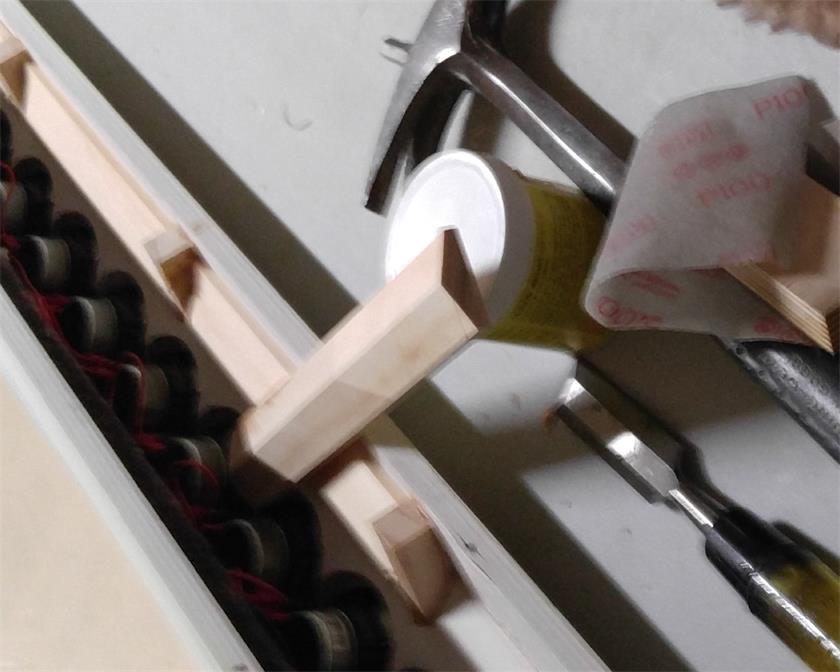
Thinking to try the recommended adhesive for gluing in the strips along the joint, I headed off to Home Depot. I couldn't find and went back to my car empty handed to find:
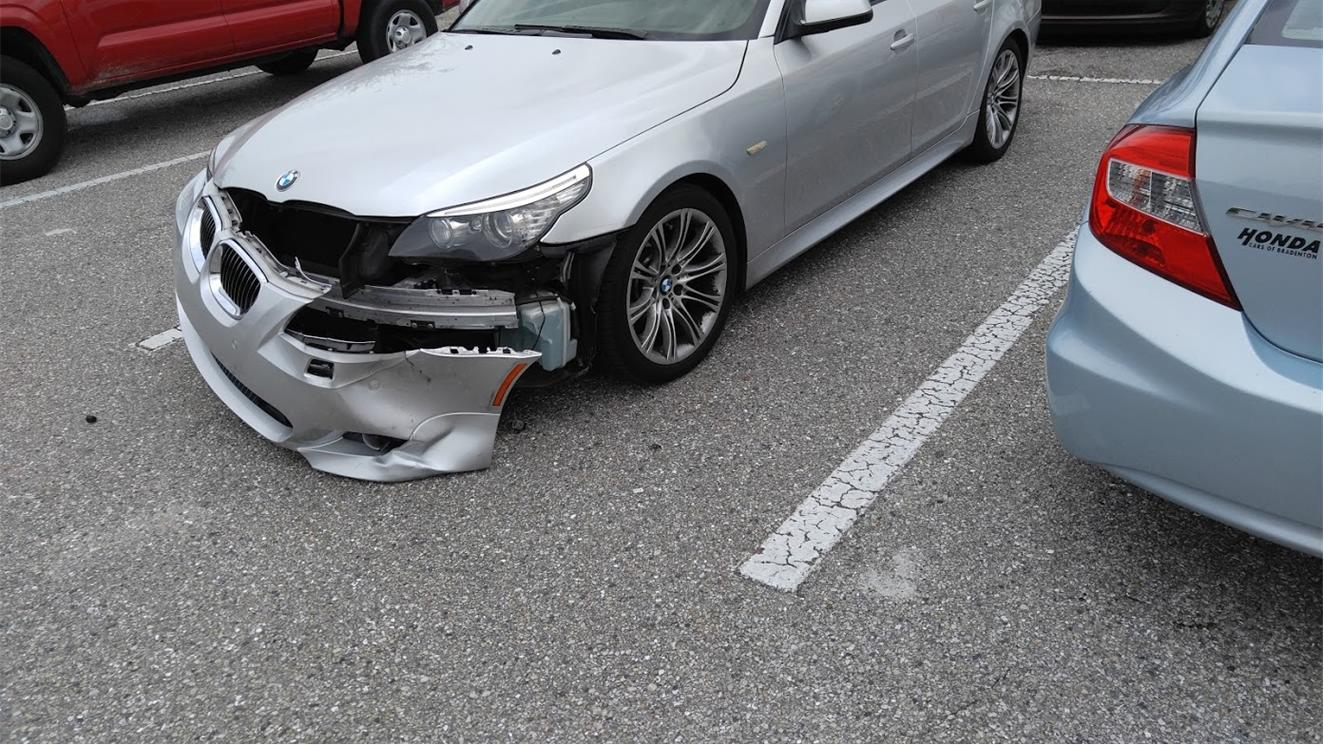
So in addition to needing to choose an adhesive for bare wood to unpainted wood, perhaps I should look for one to glue my bumper back on (just kidding, insurance claim in progress, car is mobile).
Seriously, most say I should scrape the paint off. Gorilla glue says sanding lightly will be sufficient. One construction adhesive said only one surface needs to be porous.
Thinking to try the recommended adhesive for gluing in the strips along the joint, I headed off to Home Depot. I couldn't find and went back to my car empty handed to find:
So in addition to needing to choose an adhesive for bare wood to unpainted wood, perhaps I should look for one to glue my bumper back on (just kidding, insurance claim in progress, car is mobile).
Seriously, most say I should scrape the paint off. Gorilla glue says sanding lightly will be sufficient. One construction adhesive said only one surface needs to be porous.
Attachments
Thanks Mark but plate amps are not what I'm looking for. rack mount
today I'm not so eager to DIY an amp. looking for a proaudio with quiet fans. >= 250W/ch at 8 ohms . Crown I trust to be quiet as I have a couple. QSC I don't have experience but its cheaper.
I'll take the QSC over Crown every day, at one time Crown was awesome but they sold a lot of JUNK in the 90's and 00's (including the crap they put in JBL Eon powered speakers) so I now avoid them like the plague unless you are buying their TOL gear.
It seems there is no end to my troubles. Last night I glued in some vertical supports spaced along the joints. This morning I was unsatisfied with that and so cut some pieces to fill in between those supports:
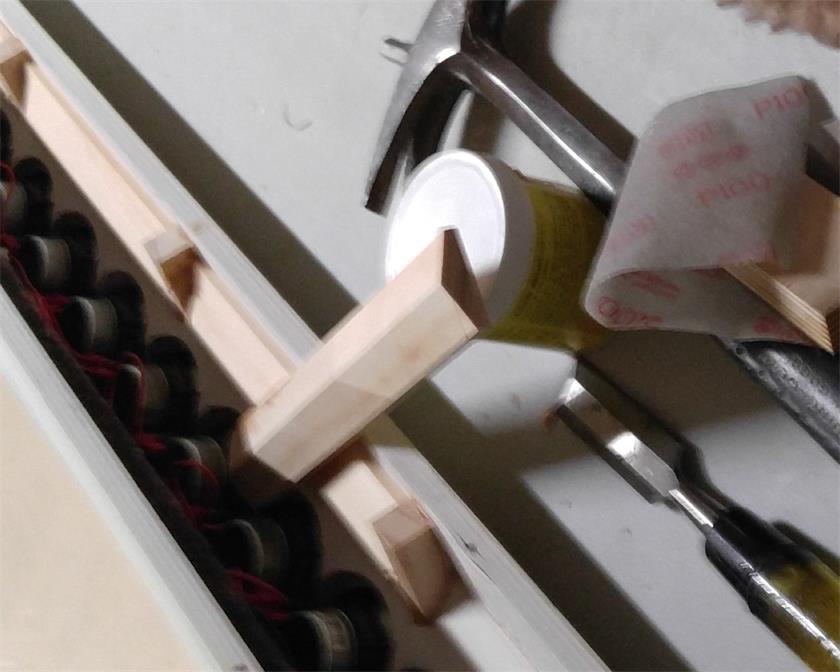
Thinking to try the recommended adhesive for gluing in the strips along the joint, I headed off to Home Depot. I couldn't find and went back to my car empty handed to find:
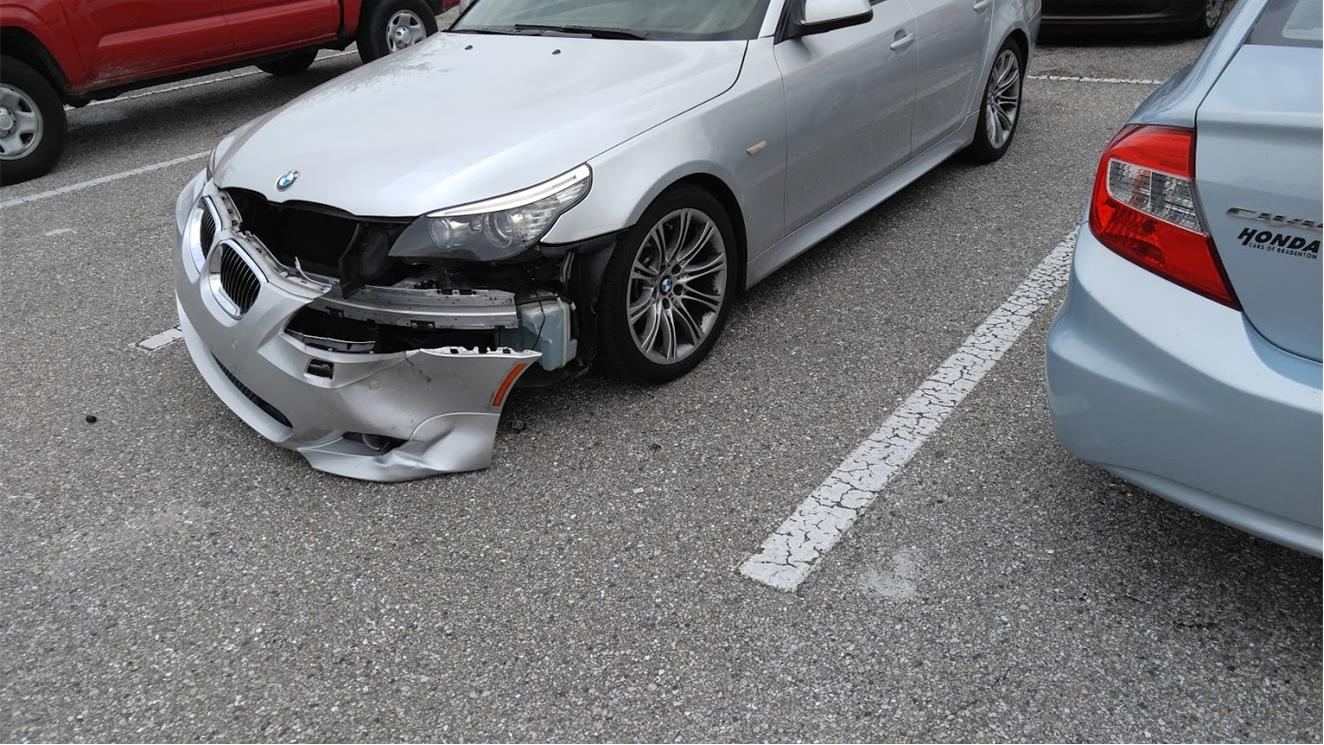
So in addition to needing to choose an adhesive for bare wood to unpainted wood, perhaps I should look for one to glue my bumper back on (just kidding, insurance claim in progress, car is mobile).
Seriously, most say I should scrape the paint off. Gorilla glue says sanding lightly will be sufficient. One construction adhesive said only one surface needs to be porous.
When it rains, it pours? 😱
Couldn't get IronGrip from Lowes either.
Just finished gluing linear strips in with PLmax.
Spent a lot of time scraping off paint to be sure of a strong joint.
New 60 ma. fan replacing 300ma. fan in my amp makes it borderline tolerable. I guess the amp stack should stay in the garage if/when the speakers move inside. Or I do have to DIY an amp afterall. Perhaps I'll scrap my old Inuke 1000 and reuse its case.
Just finished gluing linear strips in with PLmax.
Spent a lot of time scraping off paint to be sure of a strong joint.
New 60 ma. fan replacing 300ma. fan in my amp makes it borderline tolerable. I guess the amp stack should stay in the garage if/when the speakers move inside. Or I do have to DIY an amp afterall. Perhaps I'll scrap my old Inuke 1000 and reuse its case.
Finished repairing the split seam and replacing the broken driver. Put it all back together and found I was right back where I started from, perhaps a little better off.
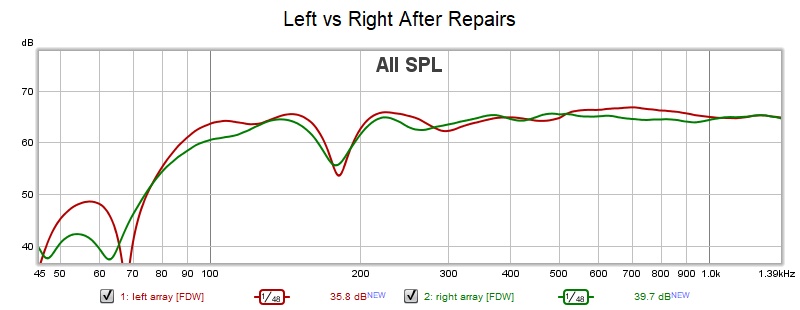
The 180 hz null is a room mode. The concern is the 3 db difference circa 100 Hz. Perhaps I can live with that but I would dearly love to explain it.
The 180 hz null is a room mode. The concern is the 3 db difference circa 100 Hz. Perhaps I can live with that but I would dearly love to explain it.
Attachments
So I did a bunch of things but the only thing that bore fruit was to clos mic each driver in the suspect array.

Drivers are numbered from the ground up. The first 8 showed anomalous responses. They are all wired in series. Investigating, I found a bad/loose crimp in the chain. When I fixed it, the anomalies went away.
But I think I know what is going on. Notice how the bass responses spread out over a 10 db range. (sorry about the scale). The drivers closest to the ends have the lowest responses. Some of that response variation might be due to mic placment but I think there is a pattern there.
The array interior is a single continuous space fully stuffed. I thought the stuffing would be sufficient to prevent lengthwise reflections but I can't think of anything else that would explain this behavior. If this is true, why then does the other array have a different and better response. I'll have to clos mic its drivers also. (tomorrow)
Drivers are numbered from the ground up. The first 8 showed anomalous responses. They are all wired in series. Investigating, I found a bad/loose crimp in the chain. When I fixed it, the anomalies went away.
But I think I know what is going on. Notice how the bass responses spread out over a 10 db range. (sorry about the scale). The drivers closest to the ends have the lowest responses. Some of that response variation might be due to mic placment but I think there is a pattern there.
The array interior is a single continuous space fully stuffed. I thought the stuffing would be sufficient to prevent lengthwise reflections but I can't think of anything else that would explain this behavior. If this is true, why then does the other array have a different and better response. I'll have to clos mic its drivers also. (tomorrow)
Attachments
I would love to see an impedance measurement of both arrays to see if there are any differences there...
I pulled out my Z jig the other day but it had the wrong connectors on it so I set it aside...
will have to pick it back up if nothing breaks today🙂
If I put in a barrier/brace to break up the tower into two chambers, do I need a total seal for it to be effective or is it sufficient to just mostly break up the sound path between the two halves?
will have to pick it back up if nothing breaks today🙂
If I put in a barrier/brace to break up the tower into two chambers, do I need a total seal for it to be effective or is it sufficient to just mostly break up the sound path between the two halves?
I completed a clos mic of the good array and present it below with a spot check of the suspect array after I repaired the loose crimp.
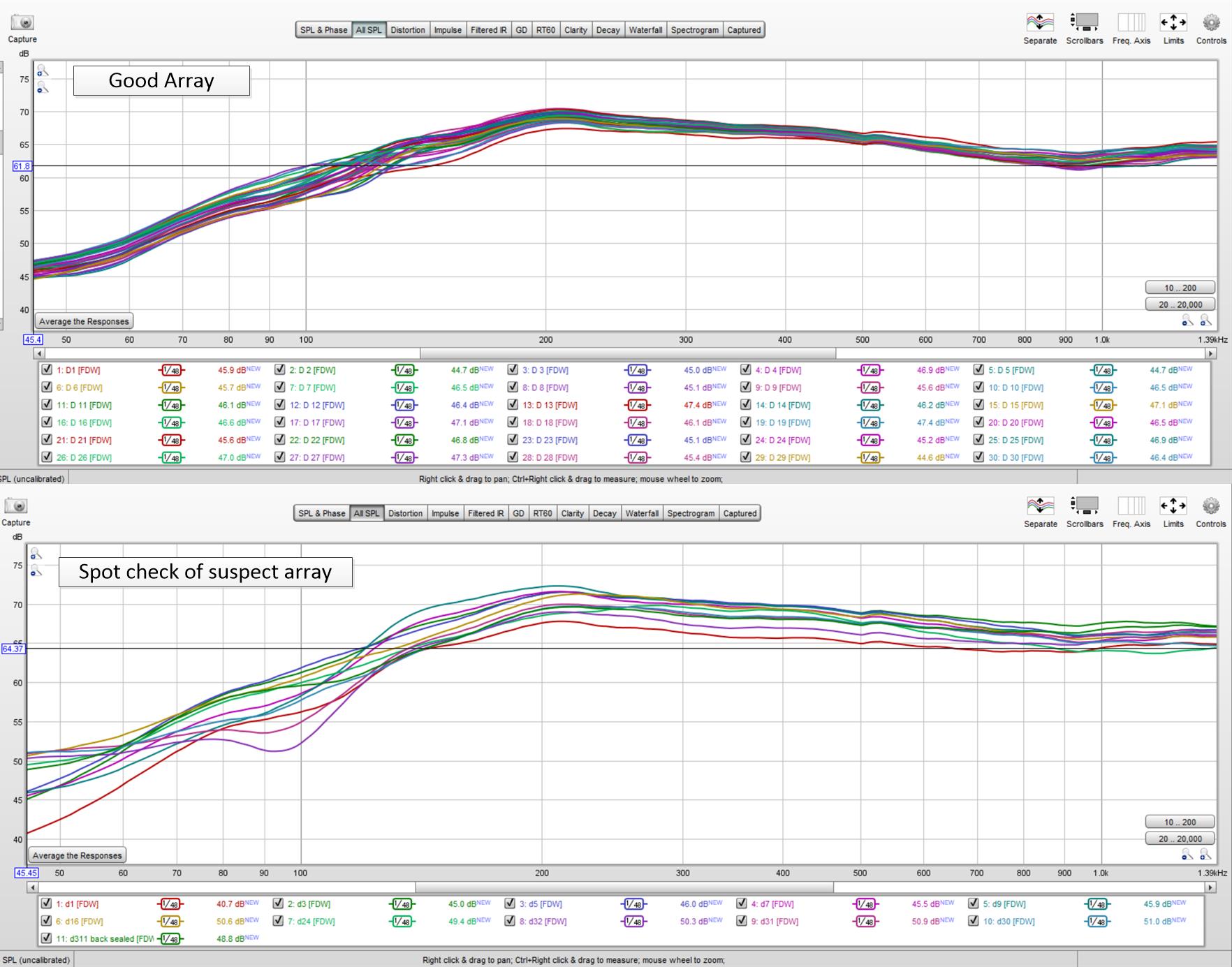
I see that the spread of 100 Hz SPL levels is much greater on the suspect array and that two drivers, and perhaps a third, are responsible for most of it. The worst drivers are 32, 31, and 1. All are at or near the ends of the array, supporting the reflection theory but they might just be weak or damaged drivers. I have one more spare that I can sub in.
But even 3 bad drivers out of 32 can't be responsible for a 3 db loss in output
I see that the spread of 100 Hz SPL levels is much greater on the suspect array and that two drivers, and perhaps a third, are responsible for most of it. The worst drivers are 32, 31, and 1. All are at or near the ends of the array, supporting the reflection theory but they might just be weak or damaged drivers. I have one more spare that I can sub in.
But even 3 bad drivers out of 32 can't be responsible for a 3 db loss in output
Attachments
Last edited:
with a finger pointing squarely at D32, I swapped in my original sample driver from my test box to that location and retested. To my mind blowing surprise that known good driver performed worst of all.
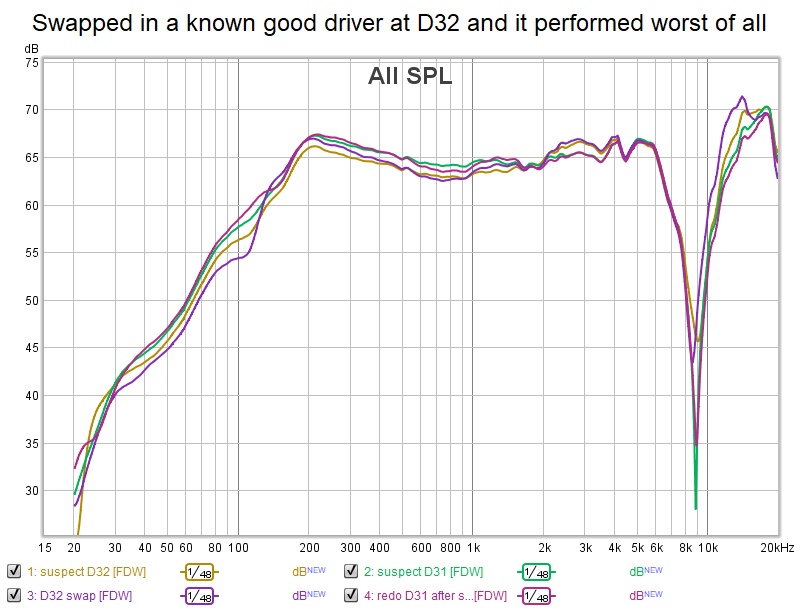
I measured at D16 for a reference furthest from an end. Its SPL was in the middle of the group at 100 Hz, which argues against the reflection/end effects theory.
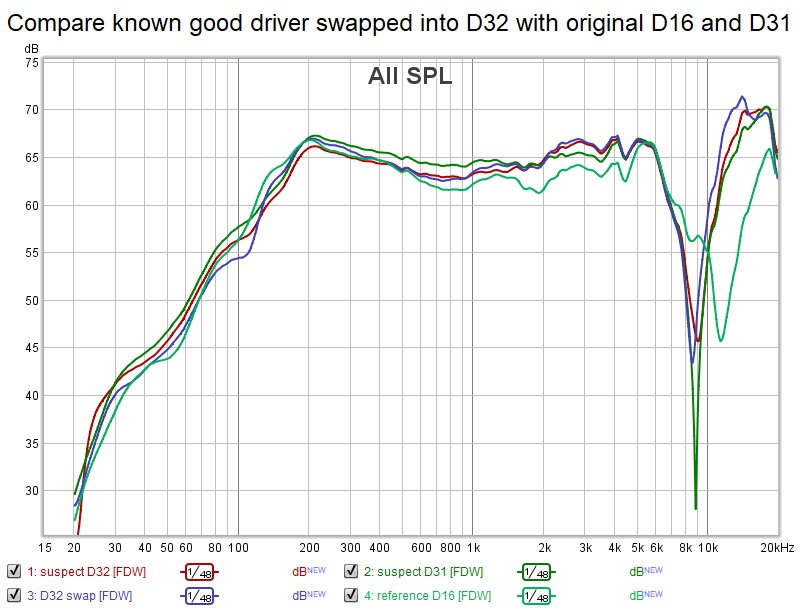
I measured at D16 for a reference furthest from an end. Its SPL was in the middle of the group at 100 Hz, which argues against the reflection/end effects theory.
Attachments
- Home
- Loudspeakers
- Full Range
- Full range line array for wall or corner placement
